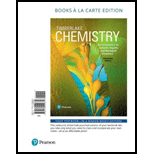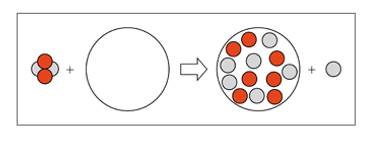
Chemistry: An Introduction to General, Organic, and Biological Chemistry, Books a la Carte Edition (13th Edition)
13th Edition
ISBN: 9780134554631
Author: Karen C. Timberlake
Publisher: PEARSON
expand_more
expand_more
format_list_bulleted
Concept explainers
Textbook Question
Chapter 5, Problem 5.53UTC

5.53 Draw the nucleus of the isotope that is bombarded in the following: (5.2)

Expert Solution & Answer
Trending nowThis is a popular solution!

Chapter 5 Solutions
Chemistry: An Introduction to General, Organic, and Biological Chemistry, Books a la Carte Edition (13th Edition)
Ch. 5.1 - Prob. 5.1PPCh. 5.1 - Prob. 5.2PPCh. 5.1 - Naturally occurring potassium consists of three...Ch. 5.1 - Naturally occurring iodine is iodine-127....Ch. 5.1 - Identify each of the following: a. 10X b. 24X c....Ch. 5.1 - Identify each of the following: a. 11X b. 3581X c....Ch. 5.1 - Prob. 5.7PPCh. 5.1 - Prob. 5.8PPCh. 5.1 - Prob. 5.9PPCh. 5.1 - Prob. 5.10PP
Ch. 5.1 - Prob. 5.11PPCh. 5.1 - Prob. 5.12PPCh. 5.2 - Prob. 5.13PPCh. 5.2 - Prob. 5.14PPCh. 5.2 - Prob. 5.15PPCh. 5.2 - Prob. 5.16PPCh. 5.2 - Prob. 5.17PPCh. 5.2 - Prob. 5.18PPCh. 5.2 - Prob. 5.19PPCh. 5.2 - Prob. 5.20PPCh. 5.2 - Complete each of the following reactions: a....Ch. 5.2 - Prob. 5.22PPCh. 5.3 - Prob. 5.23PPCh. 5.3 - Prob. 5.24PPCh. 5.3 - Prob. 5.25PPCh. 5.3 - Prob. 5.26PPCh. 5.3 - Prob. 5.27PPCh. 5.3 - Prob. 5.28PPCh. 5.4 - Prob. 5.29PPCh. 5.4 - Prob. 5.30PPCh. 5.4 - Prob. 5.31PPCh. 5.4 - Prob. 5.32PPCh. 5.4 - Prob. 5.33PPCh. 5.4 - Prob. 5.34PPCh. 5.5 - Prob. 5.35PPCh. 5.5 - Prob. 5.36PPCh. 5.5 - Prob. 5.37PPCh. 5.5 - Prob. 5.38PPCh. 5.5 - Prob. 5.39PPCh. 5.5 - Prob. 5.40PPCh. 5.6 - Prob. 5.41PPCh. 5.6 - Prob. 5.42PPCh. 5.6 - Prob. 5.43PPCh. 5.6 - Prob. 5.44PPCh. 5.6 - Prob. 5.45PPCh. 5.6 - Prob. 5.46PPCh. 5.6 - Prob. 5.47PPCh. 5.6 - Prob. 5.48PPCh. 5.6 - Prob. 5.49PPCh. 5.6 - Prob. 5.50PPCh. 5 - Prob. 5.51UTCCh. 5 - Prob. 5.52UTCCh. 5 - 5.53 Draw the nucleus of the isotope that is...Ch. 5 - Prob. 5.54UTCCh. 5 - Prob. 5.55UTCCh. 5 - Prob. 5.56UTCCh. 5 - Determine the number of protons and number of...Ch. 5 - Determine the number of protons and number of...Ch. 5 - Prob. 5.59APPCh. 5 - Prob. 5.60APPCh. 5 - Prob. 5.61APPCh. 5 - Prob. 5.62APPCh. 5 - Prob. 5.63APPCh. 5 - Prob. 5.64APPCh. 5 - Prob. 5.65APPCh. 5 - Prob. 5.66APPCh. 5 - Prob. 5.67APPCh. 5 - Prob. 5.68APPCh. 5 - Prob. 5.69APPCh. 5 - Prob. 5.70APPCh. 5 - Where does fusion occur naturally? (5.6)Ch. 5 - Prob. 5.72APPCh. 5 - Prob. 5.73APPCh. 5 - Prob. 5.74APPCh. 5 - Prob. 5.75APPCh. 5 - Prob. 5.76APPCh. 5 - Prob. 5.77APPCh. 5 - Prob. 5.78APPCh. 5 - Prob. 5.79CPCh. 5 - Prob. 5.80CPCh. 5 - Prob. 5.81CPCh. 5 - Prob. 5.82CPCh. 5 - Prob. 5.83CPCh. 5 - Prob. 5.84CPCh. 5 - Prob. 5.85CPCh. 5 - Prob. 5.86CPCh. 5 - Prob. 5.87CPCh. 5 - Prob. 5.88CPCh. 5 - Prob. 5.89CPCh. 5 - Prob. 5.90CP
Knowledge Booster
Learn more about
Need a deep-dive on the concept behind this application? Look no further. Learn more about this topic, chemistry and related others by exploring similar questions and additional content below.Atomic Number, Atomic Mass, and the Atomic Structure | How to Pass ChemistryThe Nucleus: Crash Course Chemistry #1; Author: Crash Course;https://www.youtube.com/watch?v=FSyAehMdpyI;License: Standard YouTube License, CC-BY